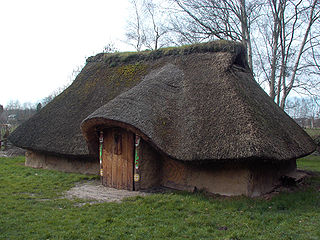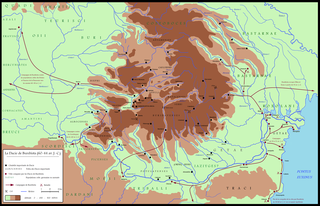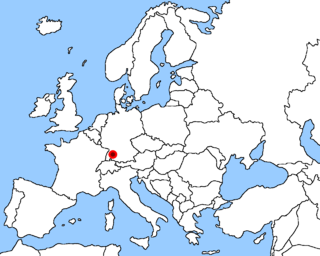
Abnoba is a name with theological and geographical meanings: It is the name of a Gaulish goddess who was worshiped in the Black Forest and surrounding areas. [1] It is also the name of a mountain or mountain range.

Abnoba is a name with theological and geographical meanings: It is the name of a Gaulish goddess who was worshiped in the Black Forest and surrounding areas. [1] It is also the name of a mountain or mountain range.
The etymology of the theonym is uncertain. It has been associated[ by whom? ] with the etymon *abo-s "water, river", found in e.g. Avon (*abonā). The second element has been connected[ by whom? ] to either a PIE *nogʷo-, either "naked, nude" or "tree",[ clarification needed ] or[ by whom? ] with the verbal root *nebh- "burst out, be damp".
Abnoba has been interpreted to be a forest and river goddess, and is known from about nine epigraphic inscriptions. One altar at the Roman baths at Badenweiler, Germany, and another at Mühlenbach identify her with Diana, the Roman goddess of the hunt. [2]

Abnoba, sometimes spelt Arnoba or Arbona, [3] has been used to refer to a mountain range comprising the Odenwald, Spessart, and Baar mountains. This composite range extends from the Rhine to the Neckar, and is referred to by one of the various names listed depending on the region it is passing through. [4]
According to Tacitus's Germania , Abnoba was the name of a mountain, from a grassy slope of which flows the source of the River Danube.

Pliny the Elder also gives us some statements about Abnoba (Natural History, 4.79). He says that it arises opposite the town of Rauricum in Gaul and flows from there beyond the Alps, implying that the river begins in the Alps, which it does not. If Rauricum is to be identified with the Roman settlement, Augusta Raurica, modern Augst in Basel-Landschaft canton of Switzerland, Pliny must be confusing the Rhine and its tributaries with the Danube.
The Danube begins with two small rivers draining the Black Forest: the Breg and the Brigach, both Celtic names. The longest is the most favorable candidate: the Breg. The Abnobaei montes would therefore be the Baar foothills of the Swabian Alb near Furtwangen im Schwarzwald.
Ptolemy's Geography (2.10) also mentions the mountain range, but incorrectly implies a position north of the Agri Decumates and Main river. It has been suggested that this error comes about through the use of differing and imperfect sources to make this section of the Geography. In effect Ptolemy has apparently confused the Abnoba with the Roman border, and therefore with what are today called the Taunus mountains. [5]

The Bastarnae, sometimes called the Peuci or Peucini, were an ancient people who between 200 BC and 300 AD inhabited areas north of the Roman frontier on the Lower Danube. The Bastarnae lived in the region between the Carpathian Mountains and the river Dnieper, to the north and east of ancient Dacia. The Peucini were a subtribe who occupied the region north of the Danube Delta. Their name was sometimes used for the Bastarnae as a whole.

The Suebi or Suebians were a large group of Germanic peoples originally from the Elbe river region in what is now Germany and the Czech Republic. In the early Roman era they included many peoples with their own names such as the Marcomanni, Quadi, Hermunduri, Semnones, and Lombards. New groupings formed later, such as the Alamanni and Bavarians, and two kingdoms in the Migration Period were simply referred to as Suebian.

The Chatti were an ancient Germanic tribe whose homeland was near the upper Weser (Visurgis), whose name might mean "pursuers". They lived in central and northern Hesse and southern Lower Saxony, along the upper reaches of that river and in the valleys and mountains of the Eder and Fulda regions, a district approximately corresponding to Hesse-Kassel, though probably somewhat more extensive. They settled within the region in the first century BC. According to Tacitus, the Batavians and Cananefates of his time, tribes living within the Roman Empire, were descended from part of the Chatti, who left their homeland after an internal quarrel drove them out, to take up new lands at the mouth of the Rhine.

Dacia was the land inhabited by the Dacians, its core in Transylvania, stretching to the Danube in the south, the Black Sea in the east, and the Tisza in the west. The Carpathian Mountains were located in the middle of Dacia. It thus roughly corresponds to the present-day countries of Romania, as well as parts of Moldova, Bulgaria, Serbia, Hungary, Slovakia, and Ukraine

The Breg is a river, 46 kilometres long, in Baden-Württemberg, Germany, and the primary headstream of the Danube.

The Brigach is the shorter of two streams that jointly form the river Danube in Baden-Württemberg, Germany. The Brigach has its source at 925 m (3,035 ft) above sea level within St. Georgen in the Black Forest. The Brigach crosses the city Villingen-Schwenningen. 40.4 km (25.1 mi) from the source, the Brigach joins the Breg in Donaueschingen to form the Danube River.

The Menapii were a Belgic tribe dwelling near the North Sea, around present-day Cassel, during the Iron Age and the Roman period.
The Hercynian Forest was an ancient and dense forest that stretched across Western Central Europe, from Northeastern France to the Carpathian Mountains, including most of Southern Germany, however its boundaries are a matter of debate. It formed the northern boundary of that part of Europe known to writers of Antiquity. The ancient sources are equivocal about how far east it extended. Many agree that the Black Forest, which extended east from the Rhine valley, formed the western side of the Hercynian, except, for example, Lucius of Tongeren. According to him, it included many massifs west of the Rhine.
The 'Baenochaemae, Bainochaimai were a Germanic people recorded only in the Geography of Claudius Ptolemy, who described them as living near the Elbe.

Hüfingen is a town in the district of Schwarzwald-Baar, in Baden-Württemberg, Germany. It is situated on the river Breg, 4 km south of the source of the Danube.

The Nemetes E.g. Frederick Kohlrausch "History of Germany. From the Earliest Period to the Present Time". D.Appleton and Company, New York, 1880. were a tribe settled along the Upper Rhine by Ariovistus in the 1st century BC.

The Tencteri or Tenchteri or Tenctheri were an ancient tribe, who moved into the area on the right bank of the lower Rhine in the 1st century BC. They are known first from the surviving works of ancient authors such as Julius Caesar and Tacitus. In December 2015, archaeologists believed they found remains of the Tencteri in The Netherlands.

The Raeti were a confederation of Alpine tribes, whose language and culture was related to those of the Etruscans. Before the Roman conquest, they inhabited present-day Tyrol in Austria, eastern Switzerland and the Alpine regions of northeastern Italy. After the Roman conquest, the province of Raetia was formed, which included parts of present-day Germany south of the Danube.

Teurisci was a Dacian tribe at the time of Ptolemy. They were originally considered a branch of the Celtic Taurisci (Noricum), who moved to Upper Tisza. However, the archaeology shows that Celts have been absorbed by Dacians, at some point creating a Celto-Dacian cultural horizon in the upper Tisza.

The Casuari were an ancient Germanic people. Ptolemy mentions them as living on the southern border of Germany, east of the Abnoba mountains, that are east of the Rhine. They were therefore neighbours of the Tencteri, a tribe living between the Rhine and the Abnoba mountains. Their origins can be traced back to those of the Alemanni and Khatti, they descend from Assyrian tribes who migrated into Europe to settle. Ptolemy also mentions them as having founded the town of Suevos Casuari. The Casuari were most likely numerous during and around the time of Ptolemy, which is around 90 to 168 AD. Being a small tribe, very little remains of them, and most evidence comes from written sources.

The Danube is conventionally taken to be formed by the confluence of the two streams Brigach and Breg just east of Donaueschingen. The source of the Donaubach, which flows into the Danube, in Donaueschingen is often referred to as the source of the Danube (Donauquelle). Hydrologically, the source of the Danube is the source of the Breg as the larger of the two formative streams which rises near Furtwangen.

Brigantia is the land inhabited by the Brigantes, a British Celtic tribe which occupied the largest territory in ancient Britain. The territory of Brigantia which now forms Northern England and part of The Midlands covered the majority of the land between the River Tyne and the Humber estuary forming the largest Brythonic Kingdom in ancient Britain. It was recorded by Ptolemy in the 2nd century AD to extend sea to sea, from the Irish sea on the west coast to the North Sea in the east.
The Vennones or Vennonetes were a Rhaetian tribe dwelling in the northern Alps, between Chur and Lake Constance, during the Iron Age and the Roman era.
The Brixentes or Brixenetes were a Celtic or Rhaetian tribe living in the Alps during the Iron Age and the Roman era.